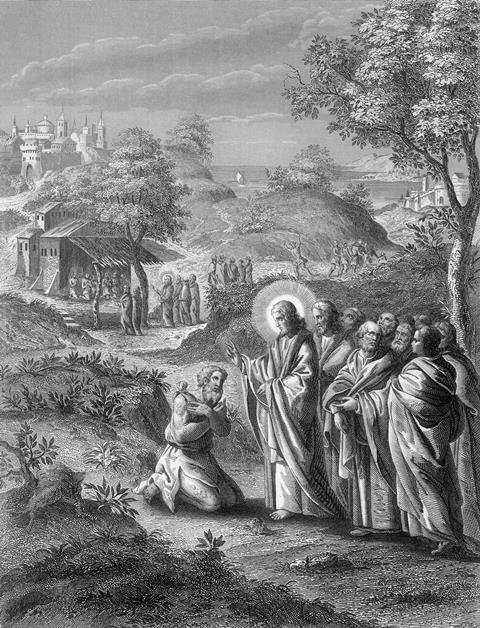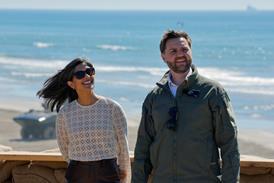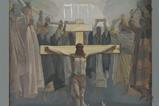Elaine Storkey looks at how the Gospel writers highlighted Jesus’ compassion towards the sick, focusing in on two specific healings noted uniquely by doctor Luke

Study passages: Luke 13:10-17; 17:11-17
Since the COVID pandemic we seem to value good health even more. Those awful images of people struggling to breathe, being carefully turned over in bed by a group of nurses, are not likely to fade from our minds any time soon. Nor are the memories of those who died from the outbreak, many of whom worked in the area of health. Hopefully, we’ve got a better understanding of viruses now. We’re even becoming more conscious of how what seems to be a common cold can turn into pneumonia and sepsis and quickly become life-threatening. My old indifference to various complaints has been replaced by twinges of acute anxiety whenever I am told that a friend or family member is showing certain symptoms.
Diseases and health care in New Testament times
All we have been through in recent years helps us to imagine what it was like in New Testament times, when good health could not be taken for granted. Disease was normal, people suffered often from malnutrition and infant mortality was high. Far too many women died in childbirth. We have skeletal remains that reveal the many disabilities that left their victims isolated.
People were often prey to infections from parasites. For example, half the hair combs found by archaeologists excavating first-century Jewish sites were infected with lice and lice eggs (Qumran, Masada and Murrabbat). Other findings suggest many people died because of infected teeth. With only basic knowledge of many illnesses and poor sanitation and hygiene, infections were not understood. Even when they were common, treatment was rudimentary. In stories related in the Gospels, many psycho-somatic conditions seem to be regarded as ‘punishment’ and the cause put down as sin.
The Gospels were written to show us the love and concern of Jesus towards those caught up in traumatic patterns of ill-health
Jesus’ care for the sick
Archaeological findings substantiate much of what we read in the Gospels about a wide range of diseases and afflictions. Yet the Gospels were not written to educate us on historical medical conditions. They were written to show us the love and concern of Jesus towards those caught up in these traumatic patterns of ill-health. Jesus’ relationship with those who were sick and his power to bring miraculous healing were evidence offered by the authors that he is indeed the Messiah, God’s anointed one, who brings life in abundance.
As all the Gospels note, healing and teaching went together in Jesus’ ministry. In Matthew, Mark and Luke many of the same healings are reported, often with dramatic impact. Jesus releases a demoniac; he heals one man with palsy and another with a withered hand. He brings Jairus’ daughter back to life. He also cures a leprosy victim, heals Peter’s mother-in-law and brings new health and hope to a woman with debilitating menstrual disorders. Yet the authors delivering these accounts acknowledge that they are relating only a few examples. They assure us that ‘multitudes’ came to Jesus and were healed.
Jesus’ miracles show us what is possible in the creation that God has made
Luke, the author of the third Gospel, was a doctor. He travelled with St Paul on his missionary journeys and wrote about the early Church in the Acts of the Apostles. He would have been very aware of the illnesses people struggled with, and the difficulties in finding cures. He would have known the strict taboos surrounding infectious diseases, and the religious protocols that isolated victims further. As someone who treated the sick himself, he would observe how much people were excluded by illness, and how physical disability brought low status and even contempt from others. His narratives show how Jesus deliberately reacted very differently to those struggling victims. In two stories, unique to his Gospel, Luke shows what impact that had.

Luke reveals the compassion of Jesus
The first story takes place in a synagogue where Jesus was teaching (Luke 13:10-17). Jesus noticed a woman who was bent double (probably with spondylitis). The fact that he saw her was interesting in itself, because to most people there she would have been virtually invisible.
As a badly crippled woman, who could not look up into people’s faces, she would have been largely disregarded. In any case the men didn’t engage with even healthy women in the synagogue, as the central worship section was strictly men only. So when Jesus called for the woman to come to him this was certainly a breach of protocol.
We can imagine that the astonishment of the other men would have increased even more when Jesus put his hands on her. They would have regarded it as highly improper and certainly not something that should be taking place on the day of worship.
Yet this poor woman’s health and wellbeing clearly mattered more to Jesus than either gender segregation or their rules. He quietly healed her and she stood up straight, praising God. Sadly, the synagogue leaders were still not impressed. They protested at the healing taking place on the Sabbath, only to be rebuked by Jesus for their hypocrisy.
In another story unique to Luke, the central characters were again effectively invisible. In their case they had to be (Luke 17:11-17). They were suffering from leprosy and forced to live in complete isolation from others because their condition was so contagious. Like the crippled woman, their state of health could only get worse as they had no hope of improvement.
Month after month their condition deteriorated as the disease spread; ulcers penetrated their skin, holes appeared in their face and nerve endings became so damaged that the victims were no longer protected by feeling pain. As their bodies became increasing disfigured fingers and toes dropped off; the loss of hands and feet made it almost impossible to move around.
Jesus was travelling with his disciples when he came upon a leper colony and was confronted by a group of ten men. Seeing Jesus in their vicinity, they called, asking for his pity. What did they want? Food, money, medicines? They may not even have known themselves. It may have simply been that to see anyone in normal health was so unusual that they took the risk of getting attention. Or they may have heard of Jesus and his reputation.
Whatever their reasoning for it, the shouting worked. Jesus heard them. Even more significant was that he looked at them and saw their human need beneath their scarred, mutilated appearance. Having been told by Jesus to show themselves to the priest, as they turned to go, they realised they had been healed.
In all his acts of healing, Jesus taught his disciples very important lessons about compassion and care for others. Sick people matter. His followers were to recognise the needs of others. They were not to turn away from the disfigured and rejected but reach out and affirm their significance. They were to realise too that healing comes from God, and Jesus could empower them to heal others.
How do we understand God’s healing today?
Healings in the Gospels represent both the wholeness of God’s creation and the way the human body can be healed and replenished. They are signs that God is repairing what has gone wrong and by putting those things to rights, restoring normality. It was theologian Jurgen Moltmann who said: “Jesus’ healings are not supernatural miracles in a natural world.
They are the only truly ‘natural’ thing in a world that is unnatural, demonized, and wounded” (The Way of Jesus Christ, SCM Press). Healings also show us something of the coming kingdom of God, in which there will be no pain and sickness (Revelation 21:4).
Jesus’ healings were miraculous and we know that sometimes God heals miraculously today through the power of the Holy Spirit. Jesus invites us to ask God in prayer for what we need, and for many of us that will include healing and recovery. But we must also recognise that physical healing is not always God’s will and, where it does not happen, we need to trust God’s reasons.
We should never suggest it is because someone’s prayers were not sincere enough, or their faith was not strong enough. We simply don’t know what God has in store for any of us but we do know we are called to trust God whatever the outcome of our prayers.
Much more common are the non-miraculous ways God has given us to restore human bodies. For this can also be seen as extensions of Jesus’ life-giving ministry. All healing points to the redemptive work of God’s kingdom and it is undertaken every day across our world. Those who give their time and skills to heal others are drawing on the power of God’s creation itself. Jesus’ miracles are also prophetic. They show us what is possible in the creation that God has made.
They disclose a future – our day – when miracles of healing and restoration are everyday affairs. For God says: “Look I have made a world where leprosy can be cured, cataracts can be removed, sight restored and limbs put together again. In my time you will see cleft lips remoulded, menstrual disorders treated, illnesses eradicated and PTSD addressed.” Our human privilege is that God uses us to bless others.

































No comments yet